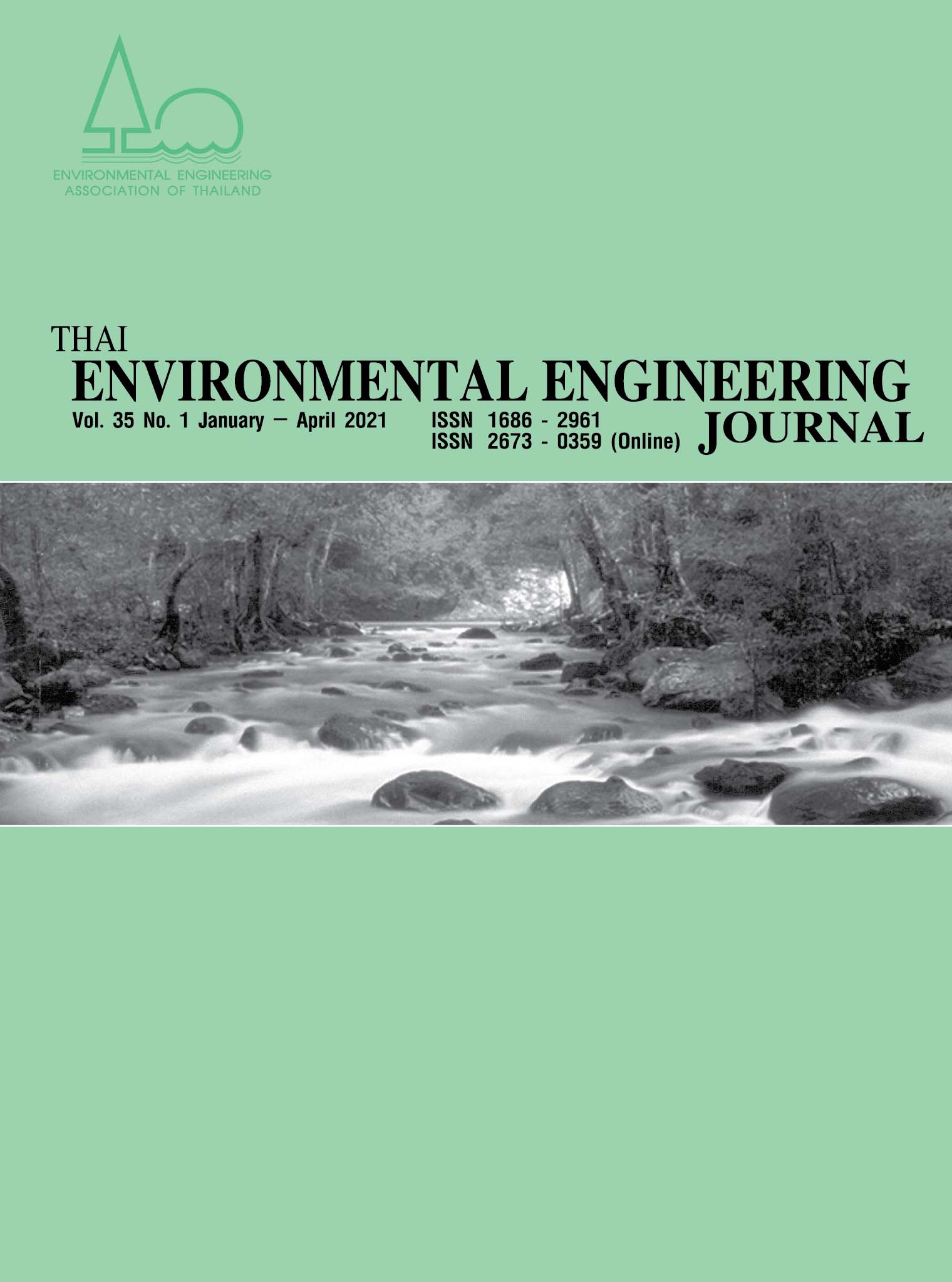The Feasibility Study of Using Microalgae for Polishing Consumer-products Industrial Effluent Containing High Total Dissolved Solids
Main Article Content
Abstract
A consumer-products industrial effluent contained high phosphate and sulfate from the manufacturing and wastewater treatment processes, resulting in high total dissolved solids (TDS) concentration. It is believed that Chlorella sp. and Scenedesmus sp. can grow in high-sulfate wastewater. The objective was to evaluate the feasibility of cultivating both algae in the industrial effluent with high TDS to polish contaminants. The culture mediums with different pH values of 3, 5, 7, and 9 and different sodium sulfate concentrations of 400, 600, 800, and 1000 mg/L were used to determine the optimum pH values and to evaluate the effects of high TDS on both algae. For both algae, the optimum pH value was 7.0, and high TDS affected minimally the specific growth rates but decreased considerably the biomass productivities due to high ionic strength. The phosphorus removal efficiency of Chlorella sp. was greater than Scenedesmus sp. because of simultaneous phosphorus assimilation and calcium phosphate precipitation. The results revealed that the lower the TDS concentration in the effluent, the higher the biomass productivities of both algae were obtained. It appears that both algae are not applicable for polishing this effluent unless nitrogen and inorganic carbon are supplemented and the TDS is reduced.
Article Details
References
Sriwiriyarat, T. and Jangkorn, S. 2009. Evaluation of Waste Activated Sludge as a Coagulant Aid for the Treatment of Industrial Wastewater Containing Mixed Surfactants. Journal of Environmental Science and Health. Part A, Toxic/Hazardous Substances and Environmental Engineering. 44(5): 508-514.
Holt, M.S. and Bernstein, S.L. 1992. Linear Alkylbenzenes in Sewage Sludges and Sludge Amended Soils. Water Research. 26(5): 613-624.
Díaz de Tuesta, J.L., García-Figueruelo, L., Quintanilla, A., Casas, J.A. and Rodriguez, J.J. 2014. Application of High-Temperature Fenton Oxidation for the treatment of Sulfonation Plant wastewater. Journal of Chemical Technology and Biotechnology. 90(10): 1839-1846.
Mungray, A.K. and Kumar, P. 2008. Anionic Surfactants in Treated Sewage and Sludges: Risk Assessment to Aquatic and Terrestrial Environments. Bioresource Technology. 99(8): 2919-2929.
Sriwiriyarat, T., Wongvian, R. and Kuhakaew, S. 2017. Selection of Coagulant with Consideration of Sludge Characteristics for Treatment of Industrial Wastewater Containing High Strength Mixed Surfactants. Chiang Mai Journal of Science. 44(4): 1654-1668.
Peressutti, S.R., Olivera, N.L., Babay, P.A., Costagliola, M. and Alvarez, H.M. 2008. Degradation of Linear Alkylbenzene Sulfonate by a Bacterial Consortium Isolated from the Aquatic Environment of Argentina. Journal of Applied Microbiology. 105(2): 476-484.
Sigoillot, J.C. and Nguyen, M.H. 1992. Complete Oxidation of Linear Alkylbenzene Sulfonate by Bacterial Communities Selected from Coastal Seawater. Applied and Environmental Microbiology. 58(4): 1308-1312.
Basha, C.A., Ghosh, P.K. and Gajalakshmi, G. 2008. Total Dissolved Solids Removal by Electrochemical Ion Exchange (EIX) Process. Electrochim Acta. 54(2): 474-483.
Pilon-Smits, E. 2005. Phytoremediation. Annual Review of Plant Biology. 56(15): 15-39.
Wang, L., Min, M., Li, Y., Chen, Y., Liu, Y., Wang, Y. and Ruan, R. 2009. Cultivation of Green Algae Cholorella sp. in Different Wastewater from Municipal Wastewater Treatment Plant. Applied Biochemistry and Biotechnology. 162(4): 1174-1186.
Chu, F., Chu, P., Cai, P., Li, W., Lam, P.K. and Zeng, R.J. 2013. Phosphorus Plays an Important Role in Enhancing Biodiesel Productivity of Chlorella vulgaris under Nitrogen Deficiency. Bioresource Technology. 134(341-356): 341-346.
He, P.J., Mao, B., Lü, F., Shao, L.M., Lee, D.J. and Chang, J.S. 2013. The Combined Effect of Bacteria and Chlorella vulgaris on the Treatment of Municipal Wastewaters. Bioresource Technology. 146: 562-568.
Martiez, M.E., Sanchez, S., Jimenez, J.M., Yousfi, F.E.l. and Munoz, L. 2000. Nitrogen and Phosphorus Removal from Urban Wastewater by the Microalgae Scenedesmus obligous. Bioresource Technology. 73(3): 263-272.
Xin, L., Hong-ying, H., Ke, G. and Jia, Y. 2010. Growth and Nutrient Removal Properties of a Freshwater Microalga Scenedesmus sp. LX1 under Different Kinds of Nitrogen Sources. Ecological Engineering. 36(4): 379-381.
Mohammadi, M., Mowla, D., Esmaeilzadeh, F. and Ghasemi, Y. 2018. Cultivation of Microalgae in a Power Plant Wastewater for Sulfate Removal and Biomass Production: A Batch Study Journal of Environmental Chemical Engineering. 6(2): 2812-2820.
Ajala, S.O. and Alexander, M.L. 2020. Assessment of Chlorella vulgaris, Scenedesmus obliquus, and Oocystis minuta for Removal of Sulfate, Nitrate, and Phosphate in Wastewater. International Journal of Energy and Environmental Engineering. 11(3): 311-326.
Andersen, R.A. 2005. Algal Culturing Techniques. Elsevier Academic Press, California.
Clescerl, L.S., Greenberg, A.E. and Eaton, A.D. 1999. Standard Methods for Examination of Water and Wastewater. American Public Health Association, Washington.
Khalil, Z.I., Asker, M.M.S., El-Sayed, S. and Kobbia, I.A. 2010. Effect of pH on Growth and Biochemical Responses of Dunaliella bardawil and Chlorella ellipsoidea. World Journal of Microbiology and Biotechnolog. 26(7): 1225-1231.
Nalewajko, C., Colman, B. and Olaveson, M. 1997. Effects of pH on Growth, Photosynthesis, Respiration, and Copper Tolerance of Three Scenedesmus strains. Environmental and Experimental Botany. 37(2-3): 153-160.
Song, Y., Hahn, H.H. and Hoffmann, E. 2002. Effects of Solution Conditions on the Precipitation of Phosphate for Recovery: A Thermodynamic Evaluation. Chemosphere. 48(10): 1029-1034.
González, L.E., Cañizares, R.O. and Baena, S. 1997. Efficiency of Ammonia and Phosphorus Removal from a Colombian Agroindustrial Wastewater by the Microalgae Chlorella vulgaris and Scenedesmus dimorphus. Bioresource Technology. 60(3): 259-262.
Enick, R.M. and Klara, S.M. 1990. CO2 Solubility in Water and Brine under Reservoir Conditions. Chemical Engineering Communications. 90(1): 23-33.
Kim, G.Y., Roh, K. and Han, J.I. 2019. The Use of Bicarbonate for Microalgae Cultivation and its Carbon Footprint Analysis. Green Chemistry. 21(18): 5050-5062.
Chi, Z., O’Fallon, J.V. and Chen, S. 2011. Bicarbonate Produced from Carbon Capture for Algae Culture. Trends in Biotechnology. 29(11): 537-541.
Mira, R., Torres, E. and Abalde, J. 2016. Effects of Sodium Sulfate on the Freshwater Microalgae Chlamydomonas Moewusii: Implications for the Optimization of Algae Culture Media. Journal of Phycology. 52(1): 75-88.
Liska, A.J., Shevchenko, A., Pick, U. and Katz, A. 2004. Enhanced Photosynthesis and Redox Energy Production Contribute to Salinity Tolerance in Dunaliella as Revealed by Homology-based Proteomics. Plant Physiology. 136(1): 2806-2817.


